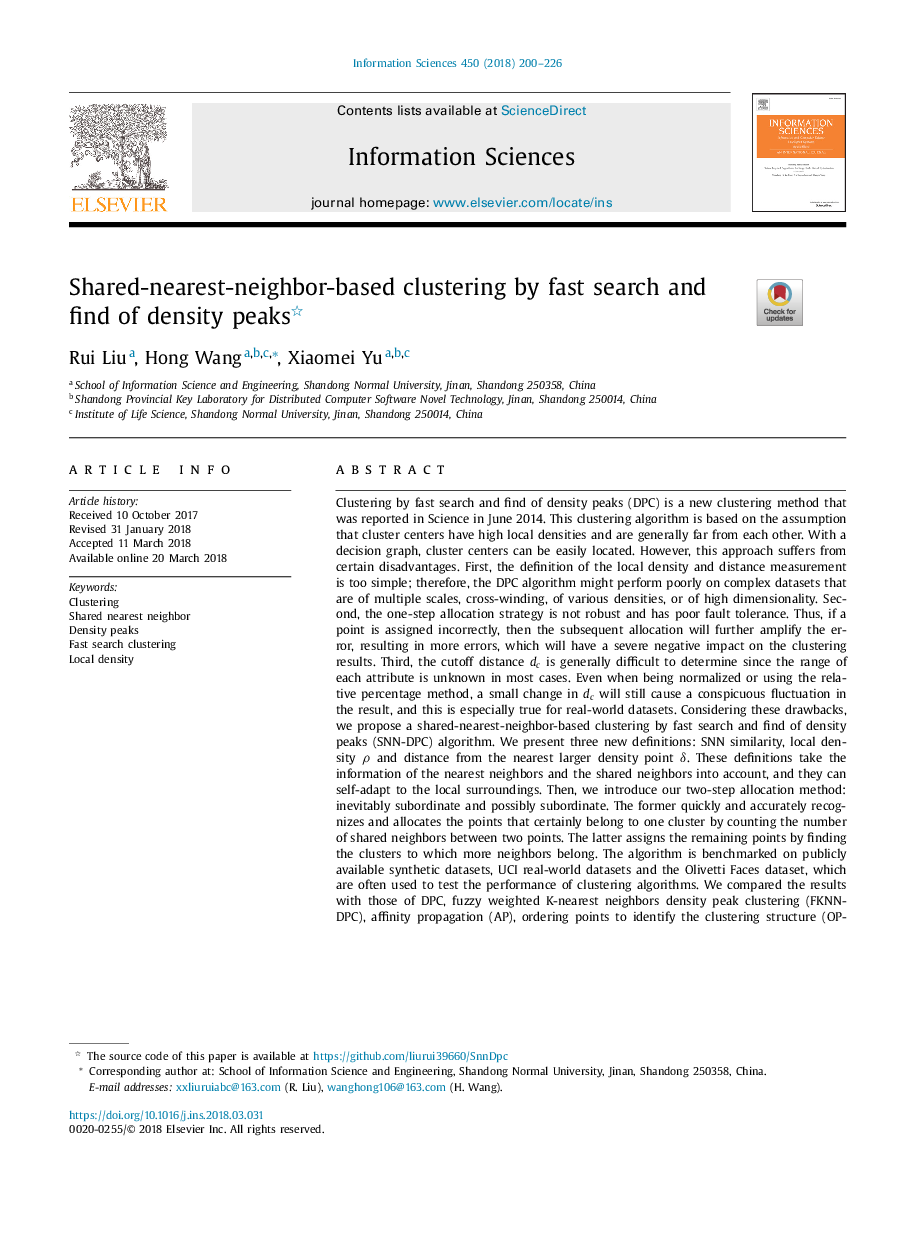| کد مقاله | کد نشریه | سال انتشار | مقاله انگلیسی | نسخه تمام متن |
|---|---|---|---|---|
| 6856466 | 1437958 | 2018 | 27 صفحه PDF | دانلود رایگان |
عنوان انگلیسی مقاله ISI
Shared-nearest-neighbor-based clustering by fast search and find of density peaks
ترجمه فارسی عنوان
با استفاده از جستجوی سریع و پیدا کردن قله های چگالی
دانلود مقاله + سفارش ترجمه
دانلود مقاله ISI انگلیسی
رایگان برای ایرانیان
کلمات کلیدی
خوشه بندی مشترک نزدیکترین همسایه، قله تراکم، خوشه جستجوی سریع، چگالی محلی،
موضوعات مرتبط
مهندسی و علوم پایه
مهندسی کامپیوتر
هوش مصنوعی
چکیده انگلیسی
Clustering by fast search and find of density peaks (DPC) is a new clustering method that was reported in Science in June 2014. This clustering algorithm is based on the assumption that cluster centers have high local densities and are generally far from each other. With a decision graph, cluster centers can be easily located. However, this approach suffers from certain disadvantages. First, the definition of the local density and distance measurement is too simple; therefore, the DPC algorithm might perform poorly on complex datasets that are of multiple scales, cross-winding, of various densities, or of high dimensionality. Second, the one-step allocation strategy is not robust and has poor fault tolerance. Thus, if a point is assigned incorrectly, then the subsequent allocation will further amplify the error, resulting in more errors, which will have a severe negative impact on the clustering results. Third, the cutoff distance dc is generally difficult to determine since the range of each attribute is unknown in most cases. Even when being normalized or using the relative percentage method, a small change in dc will still cause a conspicuous fluctuation in the result, and this is especially true for real-world datasets. Considering these drawbacks, we propose a shared-nearest-neighbor-based clustering by fast search and find of density peaks (SNN-DPC) algorithm. We present three new definitions: SNN similarity, local density Ï and distance from the nearest larger density point δ. These definitions take the information of the nearest neighbors and the shared neighbors into account, and they can self-adapt to the local surroundings. Then, we introduce our two-step allocation method: inevitably subordinate and possibly subordinate. The former quickly and accurately recognizes and allocates the points that certainly belong to one cluster by counting the number of shared neighbors between two points. The latter assigns the remaining points by finding the clusters to which more neighbors belong. The algorithm is benchmarked on publicly available synthetic datasets, UCI real-world datasets and the Olivetti Faces dataset, which are often used to test the performance of clustering algorithms. We compared the results with those of DPC, fuzzy weighted K-nearest neighbors density peak clustering (FKNN-DPC), affinity propagation (AP), ordering points to identify the clustering structure (OPTICS), density-based spatial clustering of applications with noise (DBSCAN), and K-means. The metrics used are adjusted mutual information (AMI), adjusted Rand index (ARI), and Fowlkes-Mallows index (FMI). The experimental results prove that our method can recognize clusters regardless of their size, shape, and dimensions; is robust to noise; and is remarkably superior to DPC, FKNN-DPC, AP, OPTICS, DBSCAN, and K-means.
ناشر
Database: Elsevier - ScienceDirect (ساینس دایرکت)
Journal: Information Sciences - Volume 450, June 2018, Pages 200-226
Journal: Information Sciences - Volume 450, June 2018, Pages 200-226
نویسندگان
Rui Liu, Hong Wang, Xiaomei Yu,
